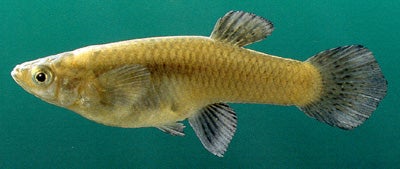MOSQUITOFISH
SCIENTIFIC NAME: Gambusia complex (G. affinis and G. holbrooki)
Characteristics: The mosquitofish is known for the large, dusky teardrop shape below its eye and one to three rows of black dots on the dorsal and caudal fins. The scales appear to be diamond-shaped because their margins are well outlined with melanophores. Females are larger than males and, when pregnant, can be extremely potbellied. Females also have a distinct black anal spot that presumably serves as a target for the male gonopodium. Individuals are generally olive green to yellow-brown on the back and upper sides, while the sides are an iridescent silver. The body shape is generally stout, with a small upturned mouth and rounded caudal fin. See Baird and Girard (1853b) for original description.
ADULT SIZE: Females: 1.2 to 2.2 in (30 to 55 mm)
DISTRIBUTION: The western mosquitofish, Gambusia affinis, occurs in Gulf coastal drainages from Alabama to Veracruz, Mexico, and northward in the Mississippi River basin to Illinois. Gambusia holbrooki, the eastern mosquitofish, is found in Atlantic coastal drainages from New Jersey to the Florida Keys and westward to the Mobile basin. In Alabama, G. affinis occurs throughout the Tennessee River drainage and northern one-half to two-thirds of the Mobile basin, while G. holbrooki is known from Gulf coastal drainages eastward to the lower Mobile River. The lower Mobile basin contains both G. affinis x holbrooki intergrade populations and G. holbrooki populations (Angus and Howell, 1996). The mosquitofish’s introduction as a control for mosquitoes has expanded its range throughout the United States.
HABITAT AND BIOLOGY: Gambusia are found in quiet pools and around the aquatic vegetation of springs, streams, rivers, ponds, swamps, large impoundments, isolated backwaters, and even waste treatment lagoons. Able to swallow atmospheric air, mosquitofish can live in poorly oxygenated environments that are marginal for many other fish species. As the mosquitofish’s name indicates, mosquito larvae and pupae are particular favorites in its diet, but it also consumes fish larvae, small crustaceans, and various amounts of algae and aquatic plants. Krumholtz (1948) reports that, beginning in late spring through the summer, three to four broods of young may be produced in a season. The gestation period for each brood lasts for 21 to 28 days.
ORIGINAL DESCRIPTION: Baird and Girard described the G. affinis in 1853, and Girard described G. holbrooki in 1859.
ETYMOLOGY:
Gambusia is from the Cuban word gambusino, “nothing.”
Affinis means related.
Holbrooki is in honor of naturalist J. E. Holbrook.
The copyrighted information above is from Fishes of Alabama and the Mobile Basin.






